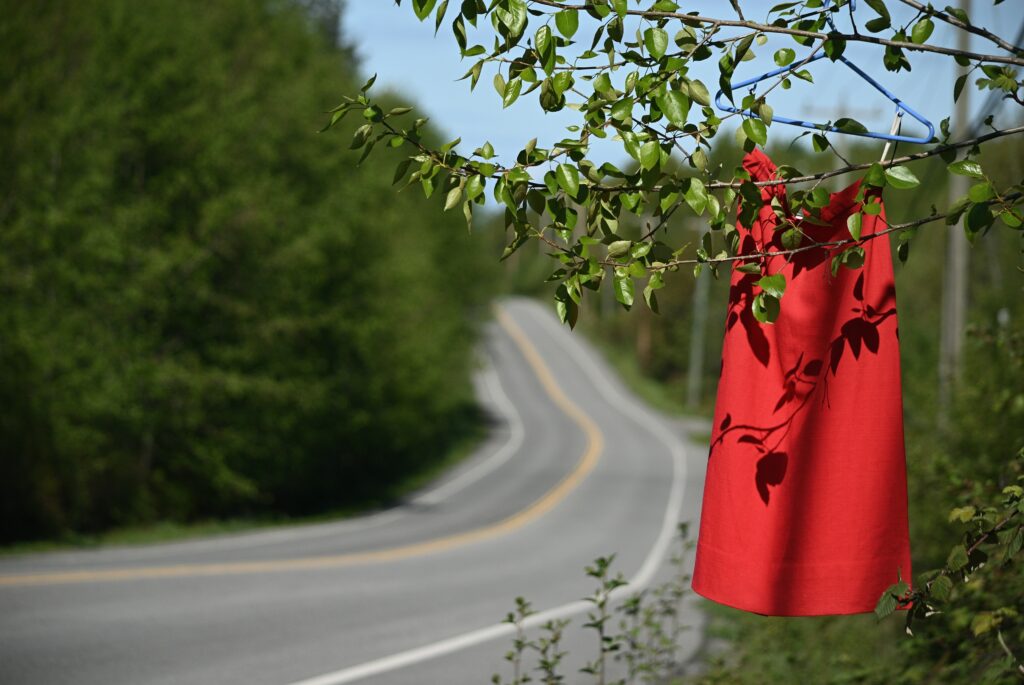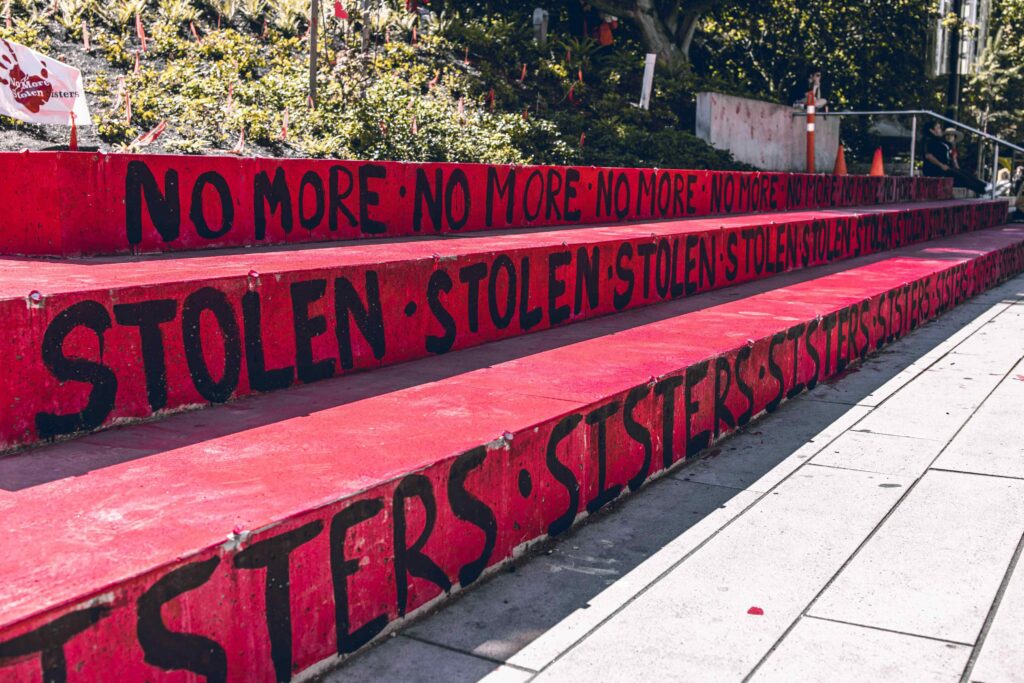Missing and Murdered Indigenous Women, Girls, and Two-Spirited People

Missing and Murdered Indigenous Women, Girls, and Two-Spirited People
Author: Sherry Woods
What? National Day of Awareness and Action is also known as Red Dress Day.
When? May 5 (every year)
Who? Missing and Murdered Indigenous Women, Girls, and Two Spirted people (MMIWG2S+)
Where? Canada (this is also a worldwide issue)
Why? Indigenous women, girls, and Two-Spirit people continue to go missing and are murdered at an alarming and disproportionate rate.
It is important to take action about this ongoing crisis. Indigenous people have lost their lives to colonial, gender-based violence, and their families and communities that live daily with the grief of losing loved ones. This violence is a direct result of the colonial history of this country.
The MMIWG2S+ genocide was the subject of a three-year National Inquiry, resulting in a Final Report and 231 Calls for Justice that outlines the immediate and sustained action required to address the overwhelming amount of violence against Indigenous women, girls, and 2SLGBTQQIA+ people. The National Inquiry closed in 2019, the Government of Canada was tasked with creating a National Action plan to address the genocide.
Indigenous women face murder rates more than 10x time the national average.
— Coalition to Stop Violence Against Native Women
Why we wear RED?
Wear red in honour of the National Day of Awareness for Missing and Murdered Indigenous Relatives. Among Indigenous tribes, it is a common belief that red is the only colour spirits can see.

History of Topic
To understand the history of this topic, you first need to be aware of the context of settler colonialism. It is important to note that the epidemic of Missing and Murdered Indigenous Women traces back to 1492. This is a significant time in Indigenous and Western history. The year explorer Christopher Columbus landed in the “New World”, specifically San Salvador which is a part of the Bahamas and was already occupied by Indigenous people before settlers’ arrival. Canada becoming a country in 1867 is another important date as this is also the same time that the federal government took authority over First Nations and land reserved for First Nations. These two events are the start of what eventually led to the racialization and violence towards Indigenous women and girls.
First Nations, Métis, and Inuit women (collectively referred to as Indigenous women) face many socioeconomic issues today because of the effects of colonization. Europeans forced a male-controlled system of government and society (known as patriarchy) on Indigenous societies, whereas their culture was previously based on matriarchy. The 1876 Indian Act disadvantaged certain Indigenous women by excluding them from band council government and enforcing discriminatory measures that took away Indian Status rights. Many Indigenous women today are leading the way in the area of healing the wounds of colonization, as they grapple with the issues of residential schools, missing and murdered Indigenous women and girls, abuse and violence, and drug, alcohol and other addictions. (McNab,2020).
Canada’s MMIWG2S movement started a national public inquiry on December 8, 2015 that the Canadian government ignored. Call to Action #41, from the Truth and Reconciliation Report states, “We call upon the federal government, in consultation with Aboriginal organizations, to appoint a public inquiry into the causes of, and remedies for, the disproportionate victimization of Aboriginal women and girls. The inquiry’s mandate would include:
- Investigation into missing and murdered Aboriginal women and girls.
- Links to the intergenerational legacy of residential schools”
This day is more personal for me it is a reminder that as an Indigenous woman, I am 10x more likely to experience some sort of violence in my lifetime. This is my reality. In 2011 my cousin Desiree Oldwoman went missing and she was never found, there has been little to no evidence of what happened to her. It has been heart-wrenching to even think about the possible horror she has been through. It put a strain on my family and our community, and we still wonder about her today. Hoping one day we can bring her home.
Homicide is the third leading cause of death among Native girls and women aged 10-24, and the fifth leading cause of death for Native women aged 25 to 34.
— Coalition to Stop Violence Against Native Women
(NWAC) Native Women’s Association of Canada – Interactive MMIWG Map
The ‘Safe Passage’ is an interactive online map showing the locations of cases of missing and murdered Indigenous women, girls and gender diverse people.
It is a community-driven, trauma-informed, and survivor-centered initiative created by the Native Women’s Association of Canada (NWAC) that tracks cases of missing and murdered Indigenous women, girls, transgender, gender-diverse, and Two-Spirit people (MMIWG2S+), monitors ongoing safety concerns, provides distinctions-based safety resources, educates the public and media about the MMIWG2S+ genocide, and commemorates and honours our stolen loved ones.
Access here: https://safe-passage.ca/

What does it mean to be a genuine ally to Indigenous communities?
- Listen to and follow the advice of Indigenous communities.
- Centre the stories around Indigenous communities.
- Learn the historical and cultural context of Indigenous People.
- When approaching a new community – never show up empty-handed. (ex. bring tobacco as an offering)
- Always seek consent and permission before approaching a new community.
- Be responsible for educating yourself. Don’t put all of the emotional labour on Indigenous People.
ACTIONS you can take as an ally to Indigenous people.
- On May 5th, wear red, take photos, and post on social media. Indigenous people are turning to social media to spread awareness. Use the following hashtags to help spread awareness on this topic:
- #MMIW
- #MMIWG2S
- #NoMoreStolenSisters
- Diversify your sources of education and entertainment. (ie. TedTalks, podcasts, documentaries, ect.)
- Read books by Indigenous authors
- Educate yourself, listen and research on Indigenous history, identity and terminology.
- Follow Indigenous artists and creators on social media platforms for more educational content and help amplify their voices.
- Donate to Indigenous led non-profits, charities, and organizations.
- Attend Indigenous events, especially in Indigenous Awareness Month.
The REDress Project
The REDress Project was started by Métis artist Jamie Black at the University of Winnipeg in 2011. It is an installation art project that focuses on the National crisis of Missing and Murdered Indigenous women and girls across Canada. The project is a series of empty red dresses hanging in spaces to symbolize the ongoing crisis of the MMIWG2S.
Red Dress Day is now observed on May 5th and it was inspired by Métis artist Jaime Black’s REDress Project installation. The empty red dresses are hung to represent the missing and murdered women. Red dresses have become symbolic of the crisis as a result of her installation.
Women are finding innovative ways to sound their voices on this issue as it is profoundly affecting communities. MMIWG2S founded itself as a movement first in Canada where grassroots efforts to raise awareness found footing around 2015. It is because of the efforts of Native women and their families that this crisis is gaining momentum. Violence against Indigenous women has always been a part of Colonialism in Canada. Since Jamie Black’s original art installation, the Red Dress Project has caught nationwide interest and more people and organizations are taking part in bringing awareness.
If you see red dresses hanging in outdoor spaces, entrances, or windows around this time of year it is likely in connection with the movement started by this art installation.
Learn more: https://www.jaimeblackartist.com/exhibitions/
Below is an image of a red dress hanging at the entrance to Strike Group’s corporate office:

———————————
References:
McNab, M. 2020. Indigenous Women’s Issues in Canada. The Canadian Encyclopedia. Retrieved from https://www.thecanadianencyclopedia.ca/en/article/native-womens-issues
———————————
About the Author:
Sherry is currently studying Communications at Mount Royal University. She is working towards using her writing talents to give voices to Indigenous People and helping to tell their stories. She is a proud member of Siksika Nation and the Blackfoot Confederacy.
